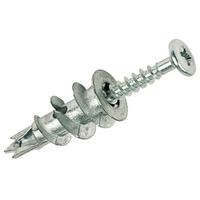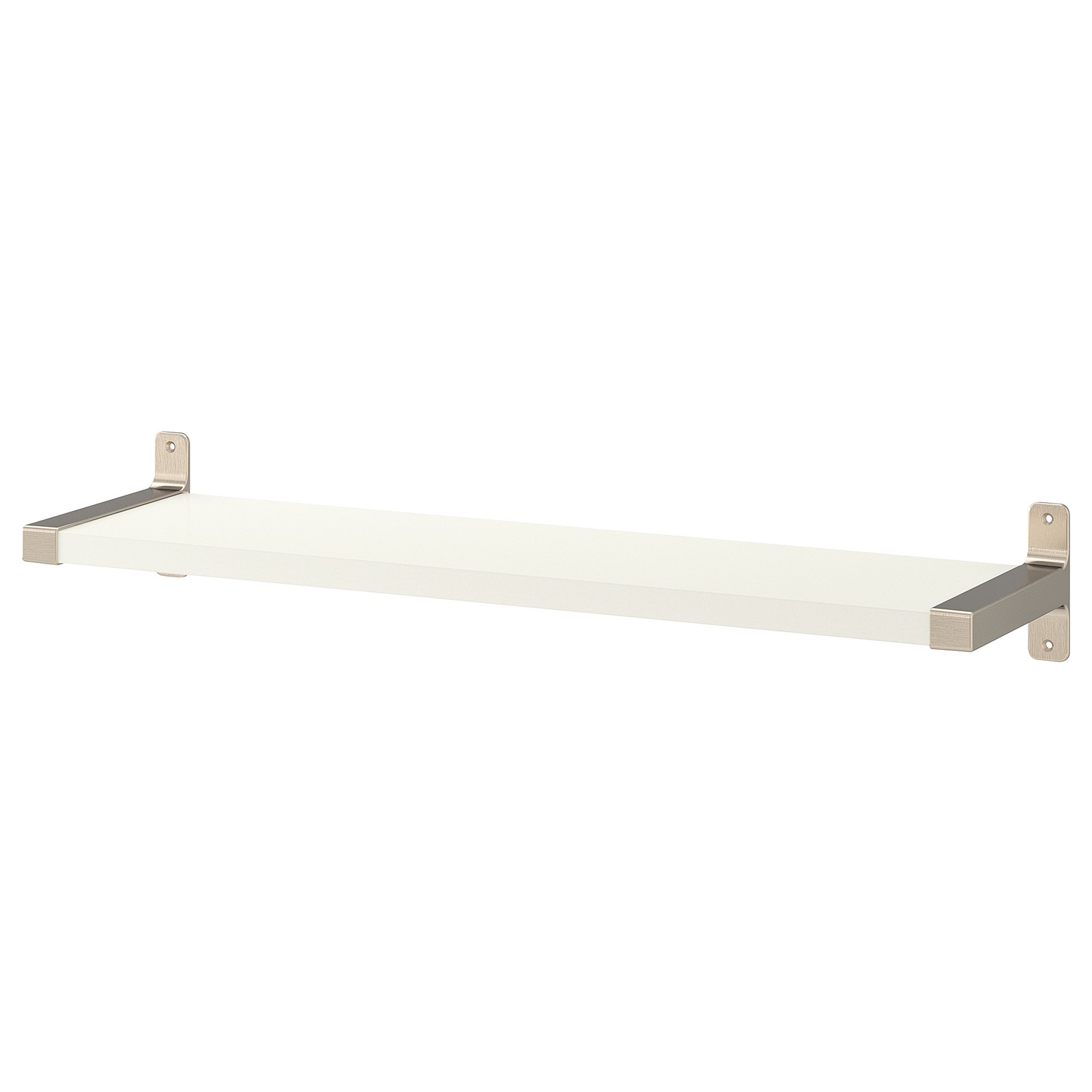MegaSack DRAW - 6pm Christmas Eve - LIVE on our YouTube Channel
Is there anyway to get floating shelves successfully mounted on plasterboard walls?
I got this http://www.diy.com/departments/form-kosto-oak-effect-shelf-l-600mm-d-230mm/3663602764458_BQ.prd
And have tried mounting with plasplug heavy duty blue things (crap) and then the metal worm screws which have a screw which goes into them.
All I have now is two saggy shelves and some holes in my wall.
Any better solutions? Its plasterboard, dabbed with a 2.5cm cavity to breeze block wall.
Dryline pro fixings are pretty good. They have a worm screw for the plasterboard and a rawl plug for the block. Spreads the load a bit. I've got them holding up the kitchen cupboards. Not cheap though. https://www.amazon.co.uk/DrylinePro-DLP050-Trade-Pack/dp/B003DAQEFE
Or hollow wall anchors are pretty good. You need the setting tool but its not that expensive. Not sure if they'd do a floating shelf. Depends what you put on it I suppose. https://www.screwfix.com/p/easyfix-hollow-wall-anchors-8-16mm-m5-x-52mm-10-pack

These have held up all my kitchen wall units and two TV mounts for 4 years and counting.
https://www.screwfix.com/p/fischer-self-drill-plasterboard-fixings-metal-35mm-100-pack/47347
I have used grip it fixings which have been successful.
A bit invasive but the best way is to carefully cut out some of the plasterboard and fit a pattress to the studs in the wall. Replace plasterboard, fill and paint. You've then got something to screw into that would be really solid.
Hollow wall finds, as per bruneeps vid up there, brilliant wee fittings, get the installation gun though for sure.
Is there anyway to get floating shelves successfully mounted
Hateful inventions. Yes, put a bracket underneath it.
Serious answer, much as per lambchop's post, you will need to substantially reinforce the plasterboard from behind with something. I have done it with a vertical length of stud timber fixed to the brickwork. Messy job though, you need to make good the board and finish again after putting them in.
robbo1234biking
Full MemberI have used grip it fixings which have been successful.
Likewise, pick the size you need and crack on
Grip it fixings are the best but that shelf is only 18mm and the Grip it holes are 25mm so it will still look rubbish.
I would take it down, repair the wall and stop buying things from B&Q.
I've used most of them and the grip it fixings are ok for right angle brackets where the load is taken vertically down the wall but, for anything heavy where there is a brick wall behind I always use Core Fix fasteners.
As said not cheap but they are very solid.
Drill through into the block behind the board and use normal plugs and long screws.
I fitted one with 7 fisher alloy plasterboard fixings that have held up big TV's cupboards and allsorts with no issues in the past, but within days it was hanging away from the wall* and I removed it before it ripped the fixings out of the wall all together.
*ok it was carpeted and had a cat jumping onto it, but the lack of cantilever in the design makes it very tough on fasteners, two additional decent fixings back into the blockwork have it solid even with the cat jumping down onto it from 3-4'
Assuming there is block behind it.
Alternatively, bin the BQ ones and go to IKEA for these, had 7 up in the kitchen holding a multitude of cookbooks since 2010.
If you can't just place it where there is a convenient joist and assuming you can buy some skim and new plasterboard and can get new paint I'd just pull the plasterboard and build in a pattress if you want to stick up anything heavier than a loo roll holder or light fitting.
The problem you have is the shelf being only 18mm thick.
The turning load from the tip of the shelf to the point at which it reaches the wall will be high compared to its relative weight and with only 18mm touching the wall it cannot spread the load out.
Kitchen cupboards although a lot heavier spread the load out over a big area.
The Ikea flowing shelves are about 50mm thick and use a concealed bracket that is almost 50mm x the full length of the shelf. I have found these to be secure on a hollow wall.
As mentioned above the best way of securing that shelf is either to fit a pattress of have a try with the corefix fixings.
as a few people have suggested, don't bother fixing it to the plasterboard at all, just fix it to the wall behind. I use frame fixings - The thing you have to be careful of is crushing the plasterboard back into the wall when you tighten them on.
The other easy solution, if you're going to have the shelves full, is fit a very low profile bracket above the shelf. something like this is hidden when books are on there..
https://www.amazon.co.uk/Brackets-Shelves-Corner-Frame-125X75mm-Anchors/dp/B07MYZ11Q3
If you have a timber framed house like mine (and not block) the best thing i found for wherever you are looking to screw something heavy to the wall, cut out plasterboard section entirely, use nice plyboard and screw to the joists set back a little from the other plasterboard then skim the ply. I have always found plasterboard to crumble and not be great when hanging really heavy things.
I hung a towel radiator doing this that is able to cope with toddlers hanging from it!
No, not the ones you have in that pic. The problem with those is that the leverage on the fixing is huge, and it's going to be too great to hold much, even if you use the hollow wall fixings. We have a lot of the Ikea style ones and even that couple of cm of extra spacing makes a huge difference to the leverage ratio, so you can put a lot more on.
The screw-in things work ok for light loads in that kind of shelf but not much else. For holding up cabinets and the like it's a completely different story, as most of the load is downward.
As above, butterfly spring toggle fixings will do the trick, have put up numerous bathroom cabinets, shelves etc. A bit fiddly but nothing's fallen down yet
toggle fixings won't work for chuff. They work well when there's a large suface which is being pulled directly towards the wall (like a cabinet) because the force holding that item up is friction between it and the wall, the force on the fixing is almost straight away from the wall
with a floating shelf the force is 'out and down' which plasterboard is not strong enough to cope with
Best bet is, and this sounds like a big job but really isn't, to cut away some plasterboard and attach wooden batons and screw directly into the wooden batons, then replace the plasterboard pieces you cut out and re-skim and paint.
Hollow wall anchors are good but with dot and dab you wont have enough space between the plasterboard and block or brick behind. However even with those you're limited to the strength of the plasterboard so need to be careful with the weight of stuff you put on the shelf. If you screw directly into wooden batons you will have more weight capacity too.
Also problem with toggle fixings where there are only 25mm dabs to blockwork. Ok in a cavity but will hit the back wall otherwise.
sorry wobblyscot - 38 seconds later
Fischer Duoblade if straight into plaster board or Duopower if into stud.
Use these for TV and kitchen cabinets hanging onto stud wall so will not be an issue for a shelf. Have a look on YouTube as some good comparison videos compared to other options.
Use these for TV and kitchen cabinets hanging onto stud wall so will not be an issue for a shelf
The loads are completely different for a tv or cabinet compared to that kind of shelf.
Hollow wall anchors are good but with dot and dab you wont have enough space between the plasterboard and block or brick behind.
In that case, you get some long frame fixings and drill into the blocks. If, as in our house, you have thermalite blocks which are really soft, you just need really long fixings. The best option with those is the hammer-in ones - tap them in a bit to get them started and splay the end of the plug then you can screw in all the way.
+1 for Corefix - used these for curtain rails in the kids bedrooms, to fix to dot/dab plasterboard over breezeblocks. solid as you like.
The loads are completely different for a tv or cabinet compared to that kind of shelf.
I did install a new floating shelf under the TV but I’ll defer to the resident ‘expert’.
I just wouldn't want the loads being transferred into the plasterboard if at all possible to avoid. Plaster board is not structural and with a shelf (unlike a cabinet) the loads are rotational so easy to pull out of the plasterboard. You can get away with it when attaching at 4 points in a square, like with a kitchen cabinet, as the loads then become almost totally in shear with very little rotational element focussed on the fixings (thing to slide down the wall rather than rotate around a single point). Obviously depends on what you're going to put on the shelf. Ideally you want to tie the loads into something rigid and structural.
However a long bolt into the block or brick behind is also good. The bolt/screw should be strong enough to support the load in bending over the relatively short unsupported length that bridges the dot and dab gap and the thickness of the plasterboard (assuming the plasterboard offers zero support but in reality it will offer some support).
Some very good advice on here. The is best was given near the start - don’t buy from B&Q
Google fu not weak. We already established that with a dot and dab wall you are unlikely to be able to use those kind of fittings as they require a good couple of inches of space behind the wall. With dot and dab you’re lucky if you’ve got much more than about 15 - 20mm of gap (yes I know I’m mixing up metric and imperial measurements).
I do this sort of thing for a living.
I particularly dislike fixing onto dot & dab. I am always nervous about fixing anything onto a wall where there is a cavity behind the plasterboard. It's always best to assume that one day it will get wet and provide no strength. Therefore, cutting a piece out, fitting a batten behind and replacing the plasterboard is the only safe way. Gosforth Handyman this week has a video that gives real life numbers and examples to back up this point.
These days I use nothing except Fischer DuoPower plugs.
Oh, and B&Q isn't always rubbish. I make and fit some really high end stuff. Sometimes some bits come from B&Q. You just need to know what you're looking at.
PSA for anyone interested - Lidl have the hollow wall anchors including the gun to set them in for £5.99 at the moment.
Picked a set up but not moving house for a couple of weeks so can't vouch for quality yet.
ANCHOR SET

You know that injectable epoxy resin you squirt into holes in masonry as an alternative to expanding plugs? You could use that and fill the gap behind the pb with it as well then insert a long piece of threaded rod. Tighten a nut and washer against the pb when it is set. Then you have a reasonably strongly attached piece of threaded rod to rest a shelf on. Or leave a short bit protruding to attach a low profile bracket to.
https://www.screwfix.com/c/screws-nails-fixings/injection-resin/cat7440007?brand=rawlplug


